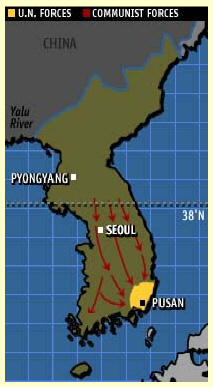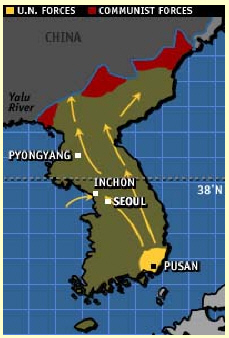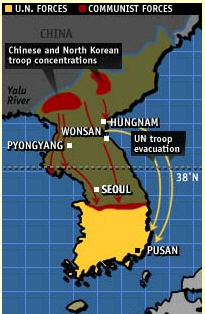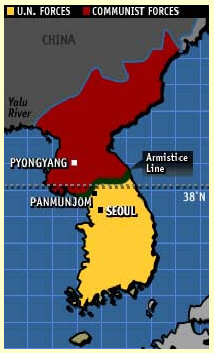Multiple Choice
Identify the
choice that best completes the statement or answers the question.
|
|
|
It was one of the few times the Cold War
went hot. The conflict on the Korean peninsula claimed millions of lives, and set the stage for the
way both sides would view each other for years to come.
A “cold war” is a war
without shooting.
A “hot war” is a war that involves shooting and killing.
The
Korean War devastated millions of lives, divided a people, involved troops from across the globe and
threatened to erupt into a Third World War.
The Soviet Union and Communist China supported and
encouraged the Communist North Koreans to invade South Korea in 1950. The U.S. and other Western
countries supported South Korea
| | | |
|
|
|
1.
|
The Korean War was
.....
a. | a hot
war | c. | a war between North Korea and
China | b. | a cold war | d. | a war between North Korea and
Russia |
|
|
|
2.
|
The _____ encouraged North
Korea to invade South Korea.
a. | Communist Chinese and South
Korea | c. | United
States | b. | Soviet Union and Communist China | d. | United Nations |
|
|
|
3.
|
In the Korean war, _____ was
the aggressor.
a. | the United
States | c. | South
Korea | b. | the United Nations | d. | North Korea |
|
|
|
INVASION
The surrender of Japan at the end of World War II also meant an end to 35 years of
Japanese occupation in Korea. As they had in Germany, Soviet and U.S. troops liberated Korea -- and
agreed to divide the nation along the 38th parallel into North and South Korea as a temporary
measure.
But as both sides withdrew their troops, they also set up rival governments, creating the
Communist People's Republic of Korea in the North, and the Republic of Korea in the
South.
|
|
|
4.
|
How long had Japan occupied
Korea before it was liberated by the United States and the Soviet Union after World War
II?
a. | 20
years | c. | 35
years | b. | 25 years | d. | 50 years |
|
|
|
5.
|
Where did the Soviet Union and
the United States divide Korea into North and South after World War II?
a. | Yalu
River | c. | 40th
parallel | b. | Chinese Border | d. | 38th parallel |
|
|
|
WAR
Stalin (the Soviet Dictator) also was heartened by the
communist victory in China in 1949 and believed it was time to open an Asian front to expand
Communism. On June 25, 1950, the North Korean army rolled south in a surprise assault.
In
the pre-dawn hours of June 25, 1950, North Korea sent an invasion force across the 38th parallel into
South Korea. The Northern forces rapidly advanced southward against the ill-equipped defenders,
taking the Southern capital Seoul three days after the invasion began. The United Nations condemned
North Korea's attack. The Soviet Union, was boycotting the U.N. Security Council at the time --
and was thus unable to veto the council's condemnation, which set up a U.N. force to help defend
South Korea.
The United States led the U.N. force in the so-called "police action"
against North Korea. But four U.S. divisions, rushed to the Korean peninsula to stop the Northern
attack, could do little against a superior force. The U.N. forces were soon forced back to a
perimeter around the southern port city of Pusan by early August. The U.N. and the U.S. troops were
trapped in Pusan. |  | | |
|
|
|
6.
|
Why did Stalin give his support
for an invasion of North Korea into South Korea.
a. | He wanted to defend Korea against
Communist China | c. | He wanted to
expand Capitalism in Korea | b. | Stalin did not support the invasion. | d. | He wanted to expand Communism into
Asia. |
|
|
|
7.
|
North Korea took the capital of
South Korea, _____ in three days.
a. | Pyongyang | c. | Korea | b. | Seoul | d. | Tokyo |
|
|
|
8.
|
Within a few weeks, the
Communist North Koreans had the United Nations and the United States forces trapped in the Port of
_____
a. | Pyongyang | c. | Pusan | b. | Seoul | d. | Yalu |
|
|
|
9.
|
Which statement below is
true?
a. | The Unites States wanted war with
North Korea | c. | The North Koreans
were not prepared for war with the South | b. | The United Nations forced the Russians out of the Security Council so they
could defend South Korea | d. | The United States and South Korea
were not prepared for war with the North. |
|
|
|
10.
|
Which of the following
countries was working with the United Nations to defeat the Communists in the Korean
War?
a. | United
States | c. | Soviet
Union | b. | Communist China | d. | North Korea |
|
|
|
 | U.N. ACTS
The United States took
advantage of a Soviet boycott of the United Nations to have the U.N. Security Council condemn North
Korean aggression -- and create a U.N. military force that would defend South Korea.
That U.N.
force included soldiers from 16 nations, with the largest contingent coming from the United States
--- all under the command of U.S. Gen. Douglas MacArthur. At first, the U.N. troops were helpless
against the North Korean assault -- and for a while appeared on the verge of being driven from the
peninsula. But General MacArthur devised a daring attack behind North Korean lines at the port of
Inchon and trapped the North Korean forces. The U.N. forces took back Seoul, the capital of
South Korea and drove the Communist North Koreans back to the Yalu river at the Chinese border.
General MacArthur was the hero of this offensive | | |
|
|
|
11.
|
Who was the leader of the
United Nations forces in Korea?
a. | General George
Marshall | c. | Sigmund
Rhee | b. | General Douglas MacArthur | d. | General George Patton |
|
|
|
12.
|
General MacArthur attacked the
North Koreans behind their front lines with a surprise troop landing at Inchon. What was the result
of this daring plan?
a. | The U.N. forces quit and the
Americans were left to fight the war themselves. | c. | The U.N. forces had to withdraw back to
Japan. | b. | The U.N. forces were defeated at Inchon and their troops were isolated at the
Port of Pusan | d. | Many North Korean troops were
captured and the U.N. forces pushed the Communists back to the Chinese border.
|
|
|
|
13.
|
The Security Council at the
United Nations is a group of the most important countries such as the U.S., the Soviet Union,
England, France, and others. Any one country on the Security Council can block the United Nations
from taking any action. Why didn’t the Soviet Union block the U.N. from taking action against
Communist North Korea?
a. | The Soviets did not like North
Korea | c. | The Soviets were boycotting the
Security Council so the U.N. authorized action while they were
absent. | b. | North Korea was not a Communist State | d. | The soviets were not part of the Security Council because they did not like
the U.N |
|
|
|
14.
|
What river acts as a natural
boundary and separates Korea from China?
a. | Mississippi | c. | Communist Pyongyang | b. | Yalu | d. | Inchon |
|
|
|
15.
|
How many United Nations were
working with the United States in the Korean war?
|
|
|
 | CHINA
North Korea's neighbor,
the People's Republic of China, watched with alarm as U.N. forces drove the North Koreans out of
the South. MacArthur assured U.S. President Truman there was no possibility of China entering the
war. But unknown to Western leaders, 500,000 Chinese -- called the People's Volunteers -- were
preparing to enter Korea.
In November 1950, China attacked -- sending the surprised U.N. forces
reeling southward. The U.N. forces were trapped by the Communist Chinese. The U.N. forces fought
their way out of the trap and retreated South of Seoul. The Communist forces took control of the
South Korean capital, Seoul, for the second time.
| | |
|
|
|
16.
|
How many Chinese soldiers
joined the North Korean army to attack the U.N. forces?
a. | 100,000 | c. | 500,000 | b. | 200,000 | d. | 1,000,000 |
|
|
|
17.
|
Why was China alarmed at the
advance of the U.N. and U.S. to its border?
a. | China did not want Western, anti
Communist forces on its border. | c. | China did not want U.N. and Soviet forces on its
border | b. | China did not want Koreans on its border | d. | China wanted to control trading on the Yalu
river |
|
|
|
 | STALEMATE
U.N. troops stopped the advance by North Korean and Chinese forces near the 38th
parallel -- and the war developed into a painful stalemate. MacArthur, had called for the bombing of
Chinese cities and pursuit of the North Korean and Chinese armies into China. He warned that the U.N.
forces had to destroy the North Korean and Chinese armies. He also wanted to get the Nationalist
Chinese forces in Formosa to help the U.N. forces. President Truman said that Korea was not a war but
a “Police Action” and he warned MacArthur to stop expressing his opinions in public.
MacArthur would not be quiet so President Truman fired him.
By the summer of 1951 armistice talks
began. It wasn't until July 1953, after months of pointless fighting and the death of Soviet
dictator Joseph Stalin, that a cease-fire was finally agreed to. Despite the armistice, the Korean
peninsula remains divided to this day -- and a potential global
flashpoint
| | |
|
|
|
18.
|
Why did President Truman fire
General Douglas MacArthur?
a. | The U.S. did not need a general
because the Korean war was really only a police action. | c. | The North Koreans and the Communist Chinese did not like MacArthur and Truman
wanted trade with the Communists. | b. | MacArthur would not obey the President and in the U.S. the civilian President
is always superior to the military officers. | d. | President Truman had a better plan for winning the Korean
War. |
|
|
|
19.
|
After years of fighting, where
was the armistice line finally drawn between North and South Korea?
a. | At the Yalu river on the Chinese
border. | c. | Right where the
war started, at the 38th parallel. | b. | South of Seoul | d. | North of Pyonyang |
|
|
|
20.
|
An armistice is an agreement to
stop fighting, it is not really a peace treaty and the nations are technically still at war.
Armistice talks between the North Koreans and the United Nations started in 1951. How long was it
before an armistice was finally signed.
a. | More than two
years | c. | We have a peace treaty in Korea but
no armistice | b. | Six months | d. | We still do not have an armistice in
Korea |
|